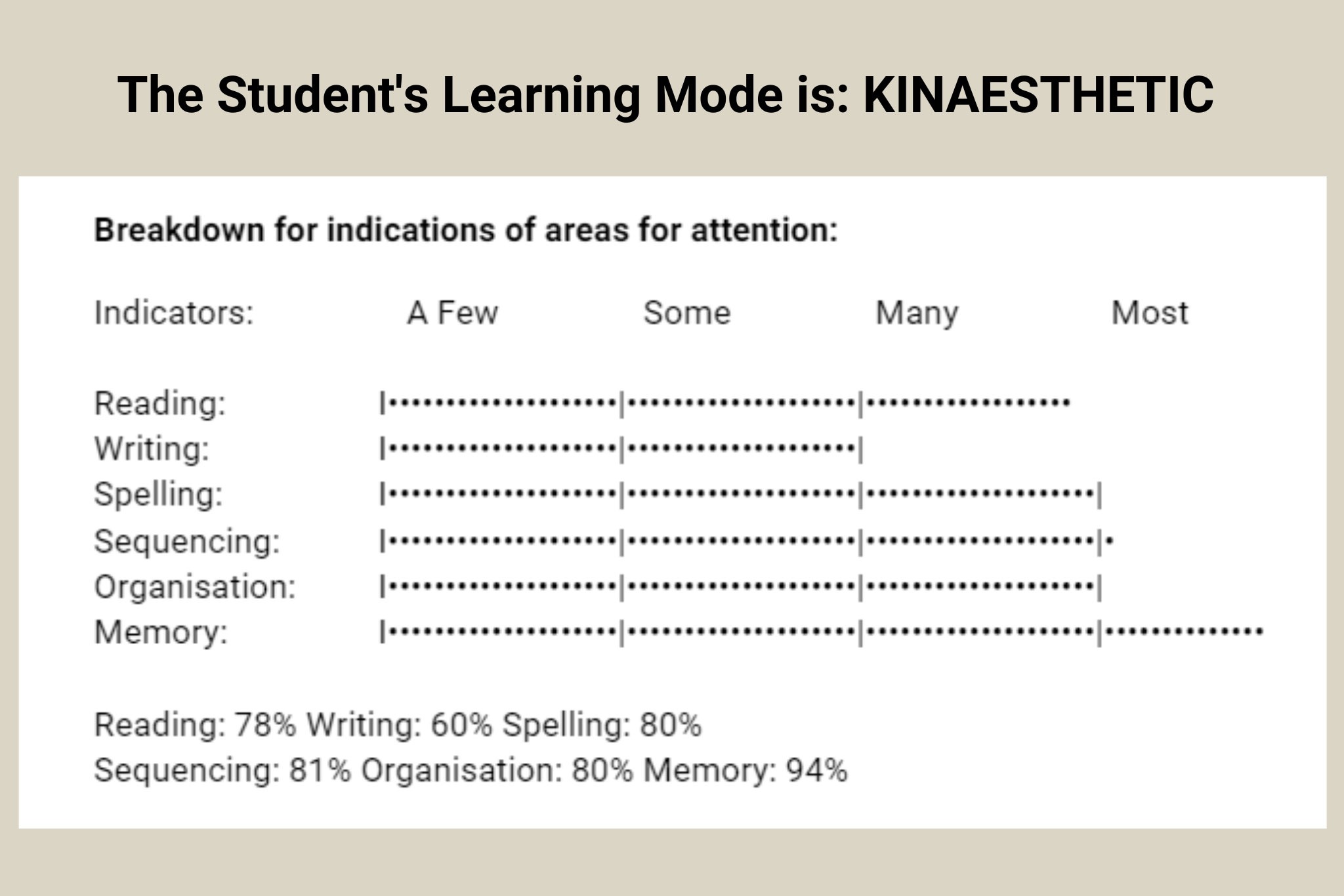
QuickScan Dyslexia Screening Test for Organisations
Would you like to provide an online dyslexia screening test for all your student intake, new recruits and colleagues, so that you can understand their strengths and if any support is needed?
QuickScan is an SpLD / Dyslexia screening questionnaire that has achieved widespread recognition as a standard initial dyslexia screener in colleges, universities and organisations across the UK and internationally.
The dyslexia screening test is suitable for those aged 14+ with a basic level of proficiency in English.
Why use the QuickScan Dyslexia Screening Test?
- The questionnaire takes between 10 – 20 minutes to complete
- A detailed report is provided to the candidate, while tutors/supervisors receive the report and a data sheet of all sessions via the admin page
- Estimated and established accuracy rate of around 90%
The QuickScan dyslexia screening test questionnaire taps into several areas of neurodiversity and identifies indicators of:
- Dyslexia, Dyspraxia (specifically hand skills) and Dyscalculia (difficulty with numbers)
- Visual stress (preferred colour background can be selected)
- General difficulties with study and literacy
- Lack of fluency in English language
- Your current preferred learning mode – a starting point in better understanding multi-sensory learning.


How to access the QuickScan Dyslexia Screening Test Questionnaire
- The QuickScan dyslexia screening test is available as on online version or can be installed on single or multiple computers
- It is provided as an annual licence starting from £250 with unlimited usage
- We recommend using a PC/laptop, Mac or large tablet – and NOT mobile phones
- Please disable pop-up blockers before completing the dyslexia screening test questionnaire
- If someone is flagged up as requiring support, they will be recommended to undertake the more comprehensive QuickScreen dyslexia test
Which Online Dyslexia Screening Test is right for my Organisation?
We offer two online dyslexia screening test options – QuickScan and QuickScreen.
You can choose to utilise one or both products depending on your requirements.
Some organisations use QuickScan to initially undertake a wider scale dyslexia screening test programme, followed by the QuickScreen test for those showing signs of SpLD for a more comprehensive online dyslexia test.
Please contact us to chat through which options could work best for you.

“We’ve been working with the QuickScan dyslexia screening test for around four years, applying it to students from a wide variety of backgrounds, studying a wide range of subjects. In the time we have been using this programme we have achieved near perfect accuracy in determining the learning styles of our students, and the appropriate ways to support them thereafter. The programme is very informal but thorough, and is very beneficial to our students whether they prove to be dyslexic or not.”
UK University
Testimonials for the QuickScan dyslexia screening test for organisations
“Thank you for the reports. It matches very well with my own perceptions. I found the dyslexia screening test very useful and fun to do. In the light of the recommendations, I will adjust my note-taking and method of studying languages, using coloured cards, and using a wider range of media.”
Secondary School Teacher
“We perform the QuickScan online dyslexia screening test upon all our first year students over two days within course confirmation; this equates to approx 800 students. We feel it is important for the correct people to run this valuable assessment so therefore support teachers and learning support assistants run the two day programme.”
Sixth Form College
“We still found QuickScan to be the most student-friendly of the dyslexia screening test questionnaires, and quick and easy to administer. In general, student responses have been very favourable and most say they have thought it beneficial to their studies.
This means that all students should know their learning style from the beginning of the year to enable them to maximise their potential. Any students who need additional support can be offered appropriate assistance from the beginning of their courses. The retention rate amongst students who receive support is particularly good.
Information about students’ learning styles from their QuickScan dyslexia screening test can be put on the database so that it is available to all tutors.”
Further Education
“The QuickScan dyslexia screening test contributes positively towards the college’s aim for students to enjoy smooth transitions into college and to life beyond and also to improving their experiences of their journeys through learning at the college.”
Sixth Form College
“The QuickScan dyslexia screening test was popular from the outset because it really was quick! It is also user friendly and no one was put off. Some of the staff found that they too had dyslexia. In some cases they had suspected this already but it was good that they had confirmation and could see why they found writing tasks difficult.”
Youth Offenders Team
“Brilliant program – so easy to get all our new intake in September to do this dyslexia screening test”
FE College
“We always include this dyslexia screening test in our induction process for new recruits”
Public Sector Organisation
“Surprising amount of information gleaned from such a short dyslexia screening test.”
Public Sector Organisation
Frequently Asked Questions (FAQs) for the QuickScan dyslexia screening test for organisations
Organisations will be issued with a QuickScan Users Manual which explains all the features of the questionnaire.
The dyslexia screening test manual outlines each item on which QuickScan reports together with clarifications. It also provides sample candidate and tutor reports.
Furthermore, details regarding the downloadable QuickScan data sheets are provided and organisations can import these into their management information systems, or use for their own research purposes.
Each organisation has its own Tutors page which allows the QuickScan dyslexia screening test reports to be accessed once completed.
A separate settings page allows the programme to be customised to suit the needs of each organisation. Other customisations to the dyslexia screening test may be available on request – please contact us.
The Tutors’ Report in the QuickScan dyslexia screening test differs from the main report for the candidate.
It contains information that the candidate would know about themselves, but the Tutor would not be likely to know, such as previous assessment status and family incidence of spelling issues.
It also contains a graphical breakdown of key diagnostic elements Writing, Reading, Spelling, Sequencing Organisation and Memory in a simple to interpret graphical form showing the level of severity of issues identified.
It further reports on laterality function (whilst left or right handedness in itself is not considered to be a relevant issue – an ambivalence in laterality function does appear to overlap with SpLD/dyslexia).
The QuickScan dyslexia screening test ends on a standard “What to do next” page, which explains what the candidate should do after completing the questionnaire.
This can either be customised and hosted by us, or may be a page on the organisation’s own learning support site.
Typically the candidate will see their dyslexia screening test report when the questionnaire is completed, though it can be withheld for later discussion with a tutor prior to being seen by the candidate.
Yes the QuickScan dyslexia screening test can be trialled in full to allow organisations to see how it will integrate with their current procedures.
The QuickScan dyslexia screening test should be completed in a single sitting and usually takes around 10-15 minutes. If it takes significantly longer than that, this may be an indication of literacy issues or speed of processing difficulties.
Neither of these issues alone is a conclusive indication of SpLD/ dyslexia but they may well be contributing factors.
With the QuickScan dyslexia screening test, you can select the screen background colour that best suits you, as well as the size of font when you start doing the online dyslexia screening test.
There are a number of visual issues that may affect reading fluency (basic visual short and long sightedness need to be ruled out as a first step), but they could also be related to visual stress which is an over sensitivity to the contrast between the font colour and the background colour.
Black printed text on white paper is one of the more problematic combinations for a person with visual stress.
Sometimes the use of coloured overlays or a change of screen colour on computer screens can make a huge difference – with eye strain and headaches reportedly being reduced and reading fluency improved.
We all absorb information through our senses. For people with dyslexia some of the filters through which learning is assimilated are erratic and it may take longer to process incoming data.
It may well be useful to find out which learning modality you are using predominantly at the present time by using QuickScan as an online dyslexia screening test. For example, many people with dyslexia are visual learners.
Since multi-sensory learning has always been accepted as the best way to acquire and retain information, then the chosen current preferred mode of learning can be seen as a starting point towards a better understanding and development of a more integrated approach.
Basing classroom teaching on individual learning styles preferences has generally been considered as not showing measurable improved outcomes.
However, the way we absorb information from around us is complex and multifaceted and not easy to categorise in simple terms. For example, linking information to previous knowledge, repetition, learning through doing things oneself, levels of motivation, being just a few.
Research shows that among people with dyslexia their intake of information through the senses is not uniform and can lead to difficulties. There is a greater overlap between the modes of learning and there are further fluctuations in how we perceive and assimilate information once it has been internalised that suggest this to be quite subjective and therefore difficult to define.
The link here is a video discussion that people with dyslexia might find very illuminating as it touches on some of these complexities.
However, the main teaching approach within the dyslexia field of making information as multi-sensory as possible has a well established foundation and, in our view, an understanding of the different learning modalities offers some useful insights to the learner rather than imposing limitations. A better level of self awareness as to how we learn is a useful tool.
There is quite an overlap between SpLD/dyslexia, dyspraxia and dysgraphia and this is reflected in the QuickScan online dyslexia screening test.
However, QuickScan specifically focuses on fine motor skills (i.e. handwriting skills) and since it is not an exhaustive list of dyspraxia characteristics, gross motor function is beyond the scope of this questionnaire and would need to be checked separately.
The QuickScan online dyslexia screening test is not accepted on its own for exam boards or by funding bodies, but it does offer a starting point for identifying individual needs.
If there are any indicators of SpLD/dyslexia, we recommend that you use the QuickScreen dyslexia test (if you aged 17+) to explore these further and put together relevant background information to present to your support team.
If you are under 17 years of age, you will find that many organisations and workplaces do, however, use QuickScan as a starting point for putting “reasonable adjustments” in place.
The QuickScan dyslexia screening test is designed to be accessible for partially sighted and blind users. It has full audio delivery for the questions and has keyboard operation available using the known “home” keys and the spacebar.
For institutions a version for deaf users was designed with a different structure to the grammar of the questions, enabling them to be more easily offered in British Sign Language by a local assistant. This is a custom adaptation for organisations.
Every item on the Tutors’ Page for each candidate is contained on lines in a downloadable spreadsheet.
This includes things like time taken to complete the sitting, font size and background colour chosen, previous assessment results and the percentage results which are shown in the graphics on the Tutors’ Page.
The full list of results on the data sheet is available in the manual that comes with the QuickScan dyslexia screening test.
All QuickScan dyslexia screening test results data is available as a downloadable comma separated values (CSV) spreadsheet which is a format supported by most systems that are able to import data.
The QuickScan dyslexia screening test is based on thorough academic and clinical experience with dyslexic adults over some 20 years.
It became quite established as an initial dyslexia screener throughout the UK over the last two decades and it has since been upgraded into an online facility and has had other features included to widen its original scope.
This includes an introductory flag for anyone with indicators of dyspraxia ( relating to hand skills in particular) and visual problems. Speed of processing which is so essential to successful study and work outcomes is also recorded and anyone who takes longer than 20 minutes would prompt a further investigation into this area, which can be verified by taking the Quickscreen dyslexia test.
The QuickScan dyslexia screen test also encapsulates the main questions that are now found on the Adult Dyslexia Checklist (available on the BDA website) and was incorporated into the question set at the time of the research project.
The rationale for the QuickScan dyslexia screening test is fully documented in the completed PhD Thesis entitled ‘Dyslexia in Higher Education’ which is available in the online library of Leicester University or by clicking on the link below:
And further explored in the publication below:
Dyslexia and Effective Learning in Secondary and Tertiary Education – Google Books
The QuickScan dyslexia screening test was used in a study of the incidence of dyslexia in a young offenders’ institution carried out by Jane Kirk and Gavin Reid, which identified a high incidence (50%) since replicated in other similar trials.
It featured in a Channel 4 documentary as part of their 2001 Dyslexia Week series Dyslexic Criminals – Polmont Prison Documentary – YouTube
REF. An Examination of the Relationship between Dyslexia and Offending in Young People and the Implications for the Training System. Jane Kirk and Gavin Reid, University of Edinburgh, UK
Need Help?
Please get in touch if you have any technical or general support questions about the test or your test results. We’re happy to help and will do our best to respond within 24 working hours.
Call +44 (0)20 8674 9571 between 9 am and 5 pm, Monday to Friday, UK time, or
Email [email protected] or use the form on our contact page.
